November 2015 ABe-Notes
November 2015 AgrAbility News
National AgrAbility News
The Assistive Technology Community of Interest met via conference call on October 15, 2015 to discuss the various aspects of liability connected to providing assistive technology services. The discussion was moderated by Steve Swain with good discussion followed. The next conference call will be on December 17, 2015 at 2 PM EST when Rod Peterson, with the Nebraska AgrAbiltiy Project, will lead a discussion on cattle working equipment for farmers and ranchers with disabilities.
The National AgrAbility Project and Indiana AgrAbility staffed a display along with Life Essentials at the 2015 National FFA Convention in Louisville, Kentucky. The display included the NAP landscape display, AgrAbility brochures, Arthritis and Agriculture publications, Back in the Saddle publications, and safety publications. Life Essentials exhibited a John Deere 2305 tractor with a loader and backhoe and seat lift, a Journeyman scooter, and an ActionTrack wheelchair.
Indiana AgrAbility News
Indiana AgrAbility exhibited at the Purdue Extension Showcase of Excellence during the Professional Development Conference for Purdue Extension educators. The conference hosted over 250 extension educators and extension specialists and provided an opportunity for educators and specialists to share information about existing and new programs and to set the vision for Purdue Extension for the next year. The Indiana AgrAbility display focused on existing programs and assistive technology, the new/beginning farmer program focusing on veteran farmers with disabilities, and conducting accessibility assessments for county fairgrounds.
November 2015 Alumni News
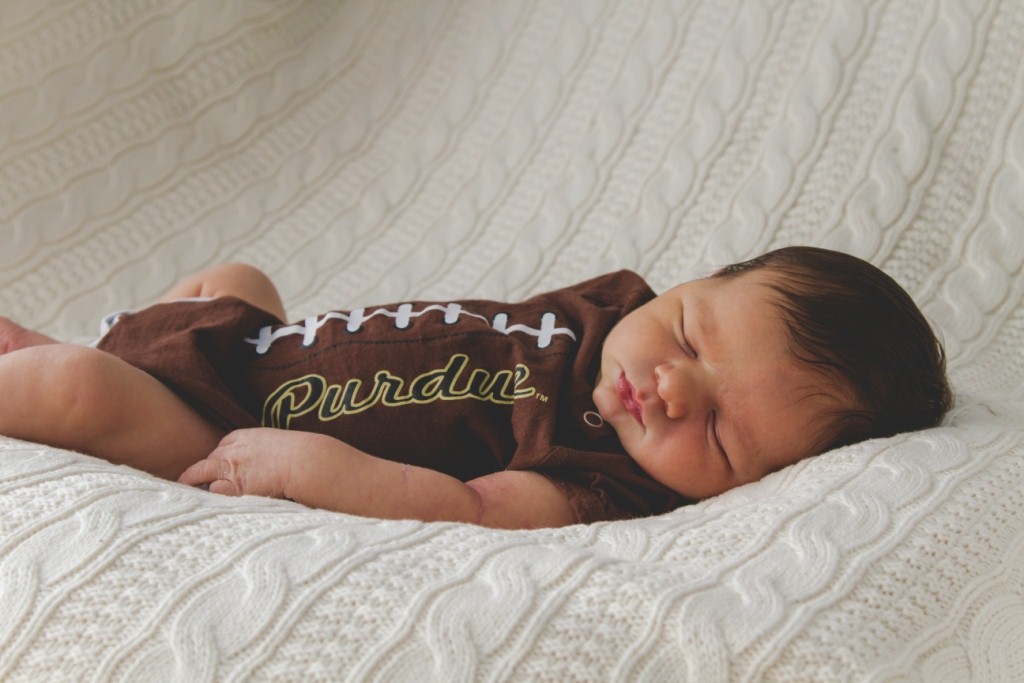 Emily (Raderer) (ABE '07) and Allen Guzik (AAE '08) welcomed their first child, Henry Thomas Guzik, on October 2, 2015. Henry arrived at 9 lb, 6 oz, and 19" long. Congratulations!
Emily (Raderer) (ABE '07) and Allen Guzik (AAE '08) welcomed their first child, Henry Thomas Guzik, on October 2, 2015. Henry arrived at 9 lb, 6 oz, and 19" long. Congratulations!
Reports are that he has been sleeping through the night since he was 3 weeks old, but we are fairly certain that is crazy talk from sleep-deprived parents.
November 2015 Faculty News
Bernie Engel traveled to Beijing China for several events between October 17 and 25. He met with the next cohorts of 2+2 undergraduate students at China Agricultural University (CAU). These students will complete 2 years in agricultural engineering at CAU before transferring to Purdue to complete their last 2 years in our program. He also met with faculty from the agricultural engineering program at CAU to work on efforts to continue to improve this program. He participated in a two day conference hosted by New York Institute of Technology and Peking University titled Megacities: Food, Energy, Water and the Built Environment where he made an invited presentation. Finally, he participated in a Agricultural Hydrology workshop at CAU making an invited presentation.
November 2015 Graduate Student News
Mahdieh Aghazadeh was one of the two graduate students that were sent to WE, the world's largest conference and career fair for women in engineering and technology, by SWE (Society of Women Engineers) between October 22 and 24 in Nashville, Tennessee, to recruit for the College of Engineering graduate programs. Purdue SWE a booth at the career fair and interacted with close to a hundred of enthusiastic undergraduate students. For more information, visit the conference website. Way to represent, Mahdieh!
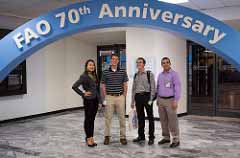 Planet Forward Blog Post - Grad students David Wilson and Jeremy Robison wrote the following in response to the time they spent in Rome at the CFS (Committee on World Food Security) at UNFAO (United Nations Food and Agriculture Organization) where they presented in front of world agricultural policy makers on empowering youth in agriculture through storytelling:
Planet Forward Blog Post - Grad students David Wilson and Jeremy Robison wrote the following in response to the time they spent in Rome at the CFS (Committee on World Food Security) at UNFAO (United Nations Food and Agriculture Organization) where they presented in front of world agricultural policy makers on empowering youth in agriculture through storytelling:
Jeremy Robison and David Wilson Reflections
Why we went to Rome
Every now and then, one gets a chance to step away from looking at life through a microscope, simply concentrating on daily tasks, and see how they can make a difference on a larger level. In October, my fellow graduate student and I did just that. My name is Jeremy Robison, and I am writing this with my fellow engineer David Wilson to share our experiences and takeaways from participating in the meeting of the Committee on World Food Security at UNFAO headquarters in Rome, Italy.
Rome - with all of its rich history, art, and gelato - is a beautiful backdrop for a story centered on solving challenges related to food security. “How?” you might ask. As winners of Planet Forward’s Story Fest, David and I were awarded a great opportunity to share our story about the Purdue Utility Platform (PUP).
Overview of project and why it is important
The PUP itself is a multi-purpose utility vehicle that can be built with local materials and tools found in rural Africa. The beauty of this vehicle is that it can be manufactured locally, sold for significantly less than similar vehicles, and can be repaired quickly and easily since local materials and tools are used. This vehicle has the ability to help solve food security problems by making transportation more accessible for people in rural areas of developing countries while providing additional utility through powering attachments and implements. With this innovation, farmers can transport people and goods faster, farther, and more affordably. This is a big deal because often the majority of roads are unpaved and there are severely limited options for motorized transportation. Additionally, people in the rural community can use attachments and implements like water pumps, maize grinders, threshers, belt driven generators, planters, and wagons.
The PUP is a great story to tell, and David and I love to share it because it has been fantastic to see how people have come together to make this project a success. We work with a great local partner in Cameroon called ACREST (African Centre for Renewable Energy and Sustainable Technologies) to implement the PUP in a rural area of Cameroon. Every year, students from Purdue University travel to ACREST to implement the designs that they have been working on. The project has now led to an opportunity for the PUP to also be built in Uganda at Makerere University.
What I came away with from CFS
The PUP has been an exciting story to be a part of, and the CFS conference provided a great opportunity to share that story while learning a tremendous amount of information. Some key areas that we learned the most from were the power of storytelling, the need to empower youth, the need for more young people to engage agriculture, the problems from climate change, and the need for sustainable soil management. Each of these plenary and side events helped educate and empower us toward taking on the responsibility of feeding the world’s ever growing population.
The biggest take-away that David and I both had from the conference was learning the importance of coupling innovations with the art of telling a story. As engineers, we have worked hard toward bringing the PUP into a tangible existence in Cameroon, but its impact as an idea can only go so far without communicating that idea to other people. That’s why being able to communicate that idea in an effective way has so much importance. Storytelling has brought the PUP from being a fun engineering project, to a scalable transportation solution.
This conference has left an impact on both David and me as it has both empowered and challenged us to respond to the ever looming challenge of global food security. We need young people to respond to this call. We need people to work as a multidisciplinary group of problem solvers and story tellers. We need good stories. After all, who doesn’t like a good story?
November 2015 Maha Fluid Power Laboratory News
Director of Maha Fluid Power Research Center Earns 2015 Koski Medal
The prestigious Robert E. Koski medal is given to honor the innovators and educators of the fluid power community. Previous awardees include Wolfgang Backe and Hubertus J. Murrenhoff— but this year, the Maha Fluid Power Research Center is proud to announce that the award has been received by Dr. Ivantysynova! Her work in designing, controlling, and furthering the understanding of axial piston machines and hydraulic transmissions has never gone unnoticed, but has here earned an exceptional form of praise. The award reception took place in Chicago at the 2015 ASME/Bath Symposium on Fluid Power and Motion Control. Great thanks goes to Beverly and Chris Koski, the wife and daughter of the award’s namesake Robert E. Koski, for attending this event and being present in this very special moment.
In spite of her standing achievements, Dr. Ivantysynova continues her work in a tireless march towards perfection. A small portion of Maha’s ongoing research was presented at the ASME/Bath Symposium by Dr. Ivantysynova’s graduate students: work on pump-switching in a displacement-controlled excavator was presented by Enrique Busquets, Maha’s blended hydraulic hybrid was explained by Hiral Haria, research on micro-surface shaping in the tribological interfaces of oil-lubricated axial piston units was presented by Ashley Wondergem, research on micro-surface shaping in the tribological interfaces of water-lubricated axial piston units was presented by Meike Ernst, and Damiano Padovani described the simulation of non-hybrid displacement-controlled hydraulic propulsion systems tailored for use in railway maintenance systems. This colorful collection of fluid power advancements was rounded out by Dr. Ivantysynova’s vision of the future of hydraulics, delivered to the conference attendees in her speech “Quo Vadis Fluid Power?” “Where is fluid power headed?” she asks— but really, she wouldn’t be a Koski medal recipient if she didn’t already know.
New Faces at Maha
The Maha Fluid Power Research Center would like to welcome Daniel Hasko, Giovanni Napolitano, and Martina Scamperle to the team. We wish you many new friends here and success in all of your endeavors!
SWAT 2015
ABE Faculty and Staff Play Key Roles at the International SWAT Conference Held at Purdue
The 2015 International SWAT conference, held at Purdue October 14-16, welcomed more than 130 users of the Soil and Water Assessment Tool. Dozens of ABE faculty, students, and post-docs served on the organizing team, volunteered, and presented their work in posters or oral presentations.
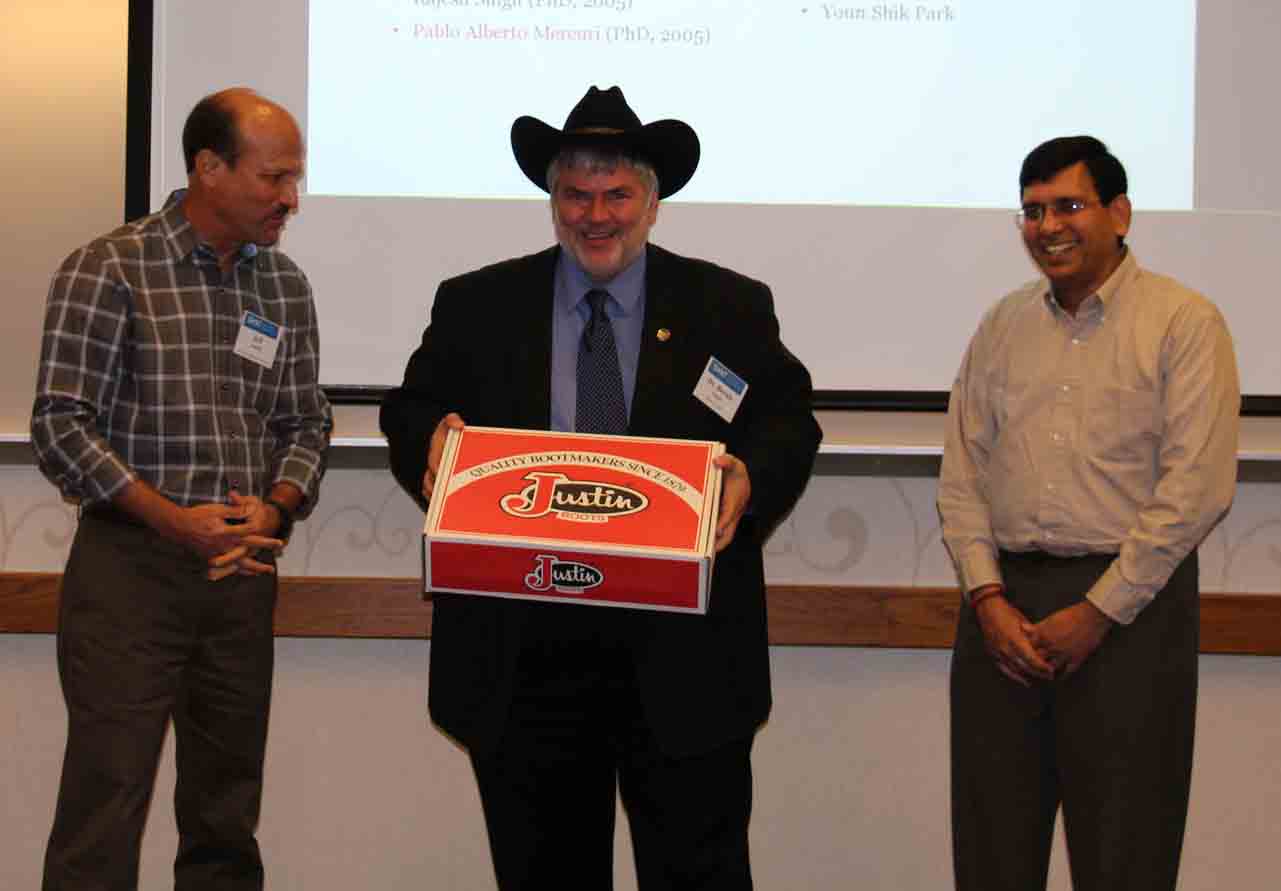 The SWAT model was originally developed at Purdue 25 years ago by two Purdue ABE Distinguished Alumni, Jeff Arnold and Raghavan Srinivasan, both PhD students of ABE Department Head Bernie Engel. Bernie served as overall chair of the conference, and was surprised by a presentation of cowboy boots and a cowboy hat by his former students who both now work in Texas.
The SWAT model was originally developed at Purdue 25 years ago by two Purdue ABE Distinguished Alumni, Jeff Arnold and Raghavan Srinivasan, both PhD students of ABE Department Head Bernie Engel. Bernie served as overall chair of the conference, and was surprised by a presentation of cowboy boots and a cowboy hat by his former students who both now work in Texas.
The conference website, http://swat.tamu.edu/conferences/2015-purdue has hundreds of photos taken by ABE student volunteers. Videos and powerpoint files for most presentations are at http://swat.tamu.edu/conferences/2015-purdue/material/.

Seven current and former students and post-docs of Indrajeet Chaubey gathered at the conference.

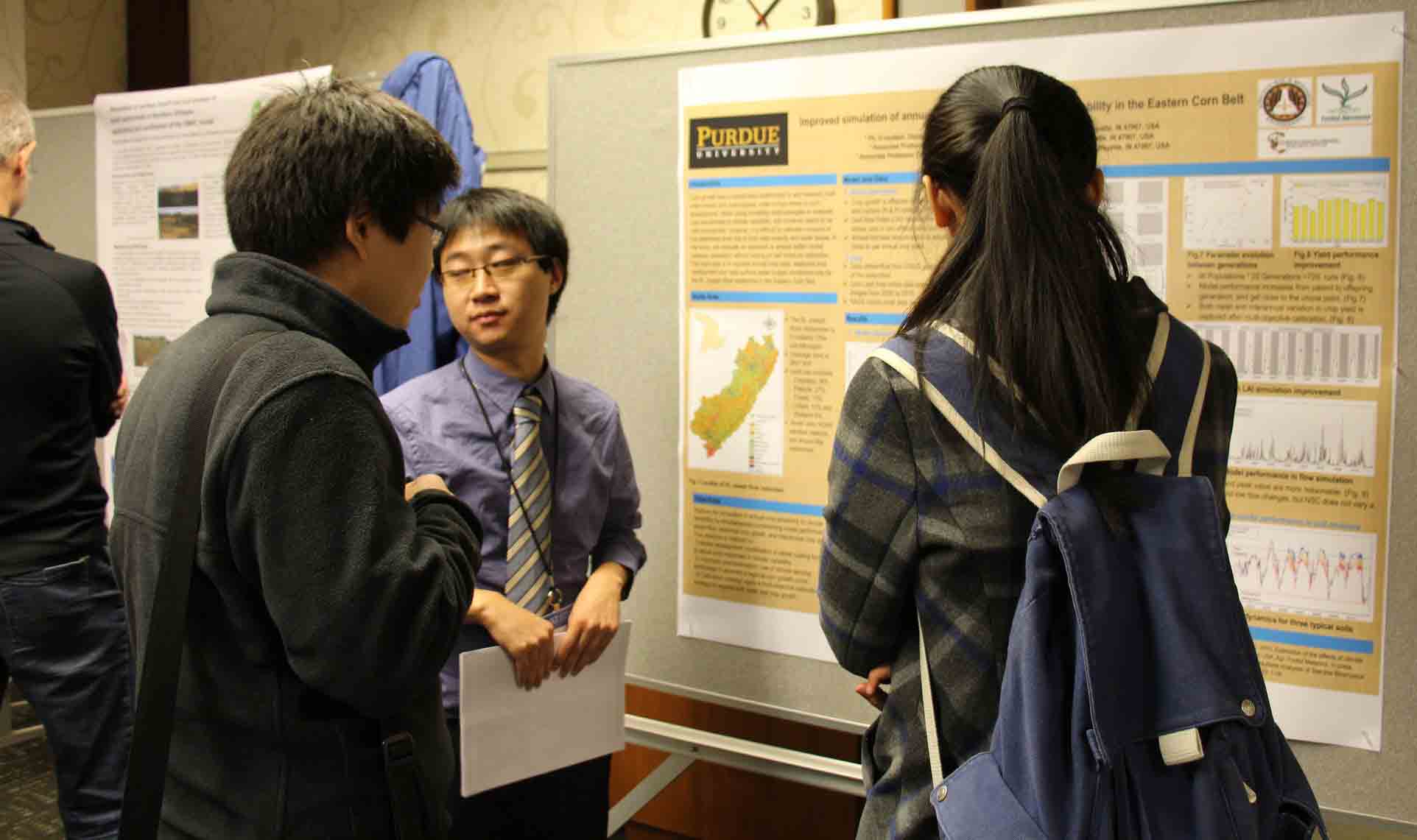
Purdue ABE graduate students attend the poster session

ABE student volunteers played key roles at the conference.

Jane Frankenberger was honored for her role developing educational materials to help users around the world use SWAT.
Welcome!
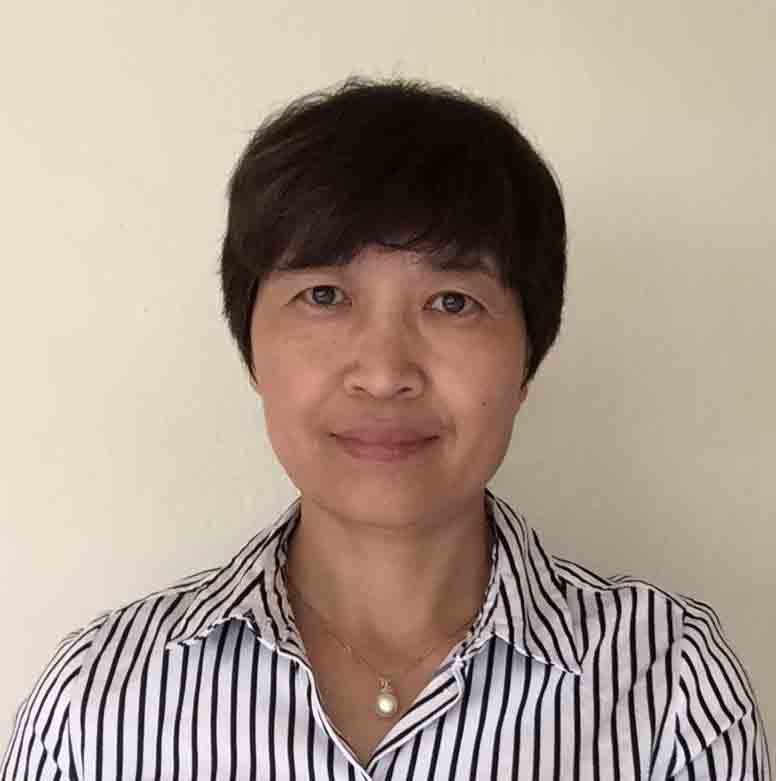 Dr. Chunyan Liu, Associate Professor, Shanghai Jiao Tong University, Shanghai, arrived at Purdue University on July 25, 2015 as a Visiting Scholar in Agricultural and Biological Engineering from July 2015 to July 2016, during which time she will collaborate on a research project on odor setback models with Professor Albert Heber. This model provides science based information about the odor impacts of livestock production to aid in determining sustainable locations for new farms. The overall goal will be to resolve conflicts by considering all pertinent factors including increased economic activity from the farms, the well-being of the surrounding community, and the impacts due to the emissions and dispersion of odor, gases, dust, and pathogens beyond the property lines. The scientific basis of the model will include veterinary medicine, animal science, ecology, economics, and agricultural and biological engineering. She will explore the relationships and separation distance between different farm sizes and operational characteristics within the communities.
Dr. Chunyan Liu, Associate Professor, Shanghai Jiao Tong University, Shanghai, arrived at Purdue University on July 25, 2015 as a Visiting Scholar in Agricultural and Biological Engineering from July 2015 to July 2016, during which time she will collaborate on a research project on odor setback models with Professor Albert Heber. This model provides science based information about the odor impacts of livestock production to aid in determining sustainable locations for new farms. The overall goal will be to resolve conflicts by considering all pertinent factors including increased economic activity from the farms, the well-being of the surrounding community, and the impacts due to the emissions and dispersion of odor, gases, dust, and pathogens beyond the property lines. The scientific basis of the model will include veterinary medicine, animal science, ecology, economics, and agricultural and biological engineering. She will explore the relationships and separation distance between different farm sizes and operational characteristics within the communities.
Contact Us
Send your thoughts on what you’d like to see in this e-newsletter to Purdue ABE at cmweaver@purdue.edu.
